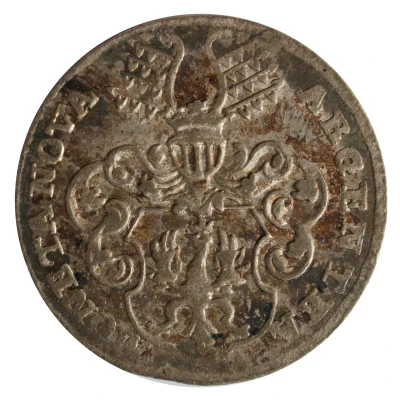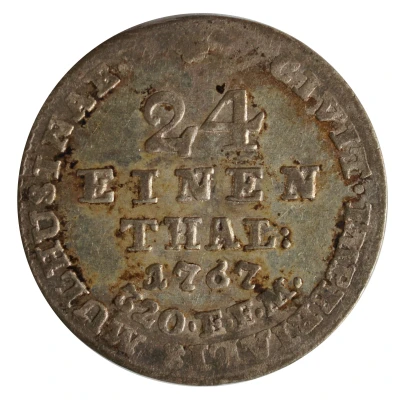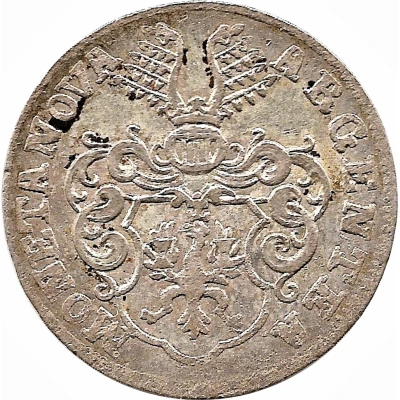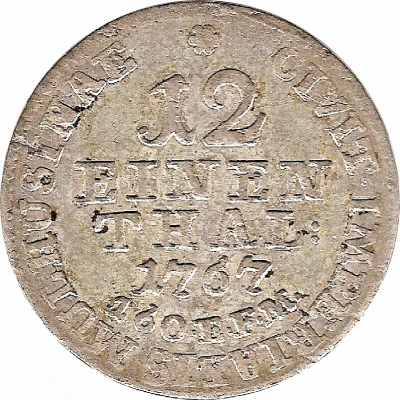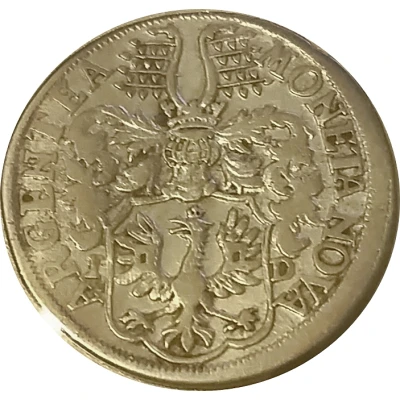
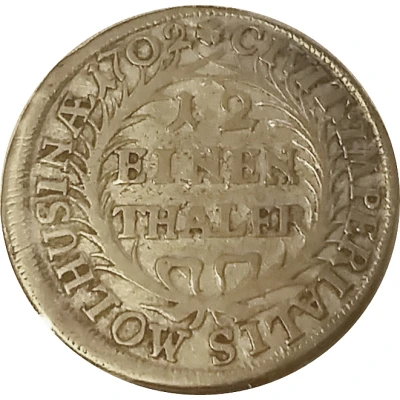

1⁄12 Thaler
| Silver | - | - |
| Issuer | Free imperial city of Mühlhausen (German States) |
|---|---|
| Period | Free city |
| Type | Standard circulation coin |
| Years | 1701-1704 |
| Value | 1⁄12 Thaler = 2 Groschens |
| Currency | Thaler |
| Composition | Silver |
| Shape | Round |
| Orientation | Medal alignment ↑↑ |
| Demonetized | Yes |
| Updated | 2024-10-05 |
| Numista | N#75986 |
|---|---|
| Rarity index | 93% |
Reverse
Value in palm wreath, date at end of legend.
Script: Latin
Lettering:
CIVIT: IMPERIALIS MOLHUSINAE 1702
12
EINEN
THALER
Comment
The "Mühlhausen Law Book" (1224) is the oldest book of law in the German language and regulated the law of the city. In 1308/09, Mühlhausen allied with Erfurt and Nordhausen against the Wettins, who tried to get these three major Thuringian cities under their rule. The alliance lasted nearly 200 years and was successful. After 1348, Mühlhausen did not have to pay any more taxes to the emperor, so that its independence was complete. The three cities pursued their own territorial policy (e.g. by buying castles) to protect their trade routes against robbery, which brought them constantly into conflict with local nobles. Another aspect of the territorial policy was buying land and villages around the city, making use of any opportunity that presented itself, for example if local rulers (counts, monasteries etc.) needed money. Mühlhausen bought 19 still existing and 43 later abandoned villages and an area of 220 km2 (85 sq mi) in this way, covering the north-western part of today's Unstrut-Hainich district. The villages had to pay taxes to Mühlhausen and were secured by the Mühlhausian Landwehr, a moat of 24 km (15 mi) length with several towers (Warte) to observe the region.Jews have lived in Mühlhausen at least since the late 13th century; the Jüdenstraße runs parallel to Steinweg in the new town. During the Black Death Jewish persecutions in 1349, many Mühlhausen Jews were killed. The Mühlhausen Synagogue at Jüdenstraße was first mentioned in 1380. Today's building is of younger origin: it was established in 1840/41 after the emancipation of the Jews in Prussia. The Synagogue was damaged during the pogrom of Kristallnacht in 1938, but it was one of only a few in Germany that survived the Nazi period and World War II. In 1998, it was reconsecrated and it is in use by the Jewish Community of Thuringia.
The economic heyday between the mid-13th and the early 16th century was a result of long-distance trade with textiles, woad and other goods. In 1286, Mühlhausen had joined the Hanseatic League. By the mid-15th century it was one of the largest cities in Germany. It became gradually more and more independent from the Holy Empire. Joined to France in 1798, it was again German after the 1870 war, and reverted to France after the WWI. It is now the French town of Mulhouse in southern Alsace.
Johann Sebastian Bach was organist of the church Divi Blasii from 1707 until 1708. Among the works Bach composed while living in the town was an elaborate, festive cantata, Gott ist mein König, BWV 71, for the inauguration of the new council in 1708.
The German mediatization led to the formal loss (that had de facto already occurred) of Mühlhausen's independence in 1803, as the city became part of Prussia. During the Napoleonic Wars it was part of the Kingdom of Westphalia from 1807 until 1815, when it became part of Prussia again according to the decisions of the Congress of Vienna. After 1815, Mühlhausen was part of the newly created Prussian Province of Saxony, where the Mühlhausen district was established.
In 1831, the Mühlhausen-born civil engineer John A. Roebling, later constructor of the Brooklyn Bridge, emigrated to the United States.
Interesting fact
The 1⁄12 Thaler coin from the Free Imperial City of Mühlhausen (German States) made of Silver is interesting because it was minted during a time of great economic and political change in Europe. The coin was issued between 1701 and 1704, a period when many German states were transitioning from a feudal system to a more modern, centralized government. The coin's silver content and intricate design also reflect the advanced minting techniques and artistic craftsmanship of the time.
